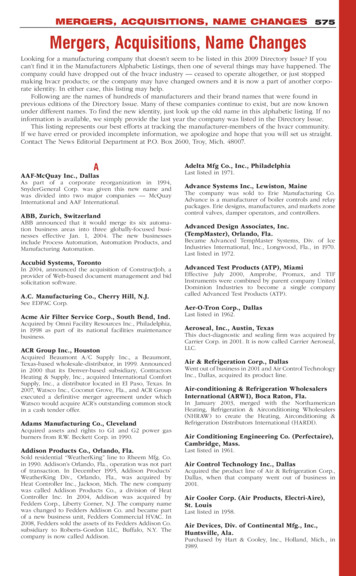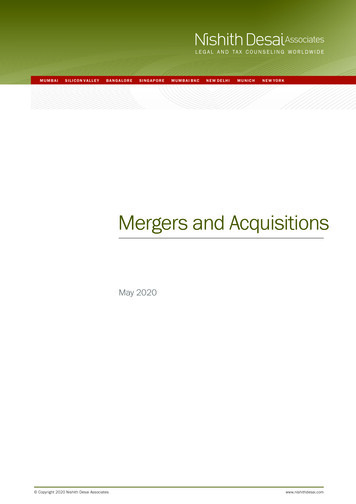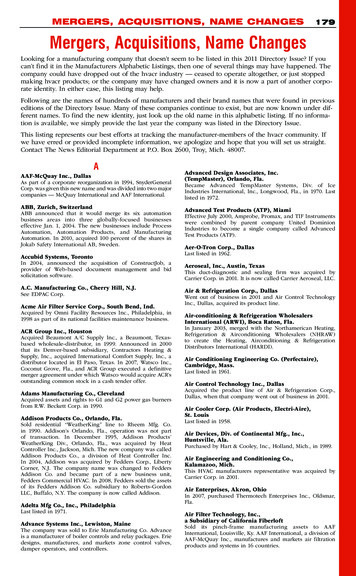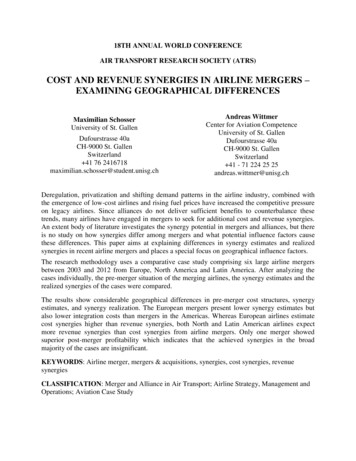
Transcription
International Journal of Advanced Research inManagement and Social SciencesISSN: 2278-6236Impact Factor: 4.400MERGERS AND ACQUISITIONS IN THE INDIAN BANKING SECTOR: A STUDY OFSELECTED BANKSKomal Gupta*Abstract: In the present era of global economy, Mergers and Acquisitions have become themost widely used business strategy of corporate restructuring and strengthening to achievegreater market share, long term profitability, entering new markets, capitalising oneconomies of scale etc. The present paper evaluates the effects of merger and acquisitionson the financial performance of the selected banks in India. Pre and post merger comparisonis conducted on selected variables to analyse the effectiveness of mergers and acquisitionson the banks. Two cases of merger and acquisitions have been taken randomly as sample forthe study, first the merger of ICICI bank and The Bank of Rajasthan, and second the mergerof HDFC bank and Centurion Bank of Punjab. The results of the study indicate that there is apositive impact of mergers and acquisitions on the financial performance of the selectedbanks.Key Words: Mergers and acquisition, Banking, Financial Performance, Financial Ratios,Synergy.*Assistant Professor, Maharaja Agrasen College, Delhi UniversityVol. 4 No. 3 March 2015www.garph.co.ukIJARMSS 94
International Journal of Advanced Research inManagement and Social SciencesISSN: 2278-6236Impact Factor: 4.400INTRODUCTIONGrowth is the norm in the present times of cut throat competition. A firm can achievegrowth either internally by expanding its operations, establishing new units or externallythrough mergers and acquisitions (M&As), takeover, amalgamations, joint venture etc. Withthe level of competition getting intense day by day, Mergers and Acquisitions have emergedas the most preferred long term strategy of corporate restructuring and strengthening inthe present globalised world. The main rationale behind the Mergers and Acquisitions is tocreate synergy that is one plus one is more than two.Banking sector plays a crucial role in the economic growth and development of a nation.Globalisation, deregulation of economies coupled with technological development haschanged the banking landscape dramatically. With the fast changing environment, thebanking sector is resorting to the process of consolidation, corporate restructuring andstrengthening to remain efficient and viable. For this, Mergers and Acquisitions havebecome the preferred strategy for growth in the size of banks which in turn play a significantrole in entering the global financial market. Besides Mergers and Acquisitions are widelyused for achieving higher market share, overall productivity and profitability, expandingbranch networks, strengthen their capital base, cost rationalisation, economies of scale andmanpower efficiency.Mergers and Acquisitions in Indian banking sector have been initiated in response to thevarious economic reforms introduced by the government of India since 1991, in its movetowards liberalisation, privatisation and globalisation. On the recommendation ofNarshimam Committe I (1991), Narshimam committee II (1997) and Verma Committee(1999) policy makers cautiously introduced various reforms in the Indian Banking Sector.The main objective of these reforms was to improve the efficiency of the Indian banks andto promote a diversified and competitive financial system.As the economies grow the banks have to grow in order to provide credit. SBI chairmanArundhati Bhattacharya (2014) recently highlighted “As the economy of India will grow,India will need bigger banks. Now, to build bigger banks organically is very difficult. So to doit in an inorganic way by clubbing some of the banks will probably be the best route.” Whencompared with global rivals, India’s banks are still very small. SBI, the country’s largest bankis ranked 16th while Bank of Baroda is at 32 in Asia. Therefore Mergers and Acquisitions areVol. 4 No. 3 March 2015www.garph.co.ukIJARMSS 95
International Journal of Advanced Research inManagement and Social SciencesISSN: 2278-6236Impact Factor: 4.400being looked as a strategy for creating large banks with a pan-India presence. For this veryreason the finance ministry is also presently examining various options to merge thecountry’s biggest state run banks to create much stronger financial institutions.The waves of mergers and acquisition started in United States and Europe and had thenspread to other countries around the world. Most of the studies on banks M&A havefocused on the United States and Europe. With this perspective the present study aims toexamine the post merger financial performance in Indian Banking Sector to assess thesuccess of merger.LITERATURE REVIEWUnder this study an extensive review of literature has been carried out for the purpose ofproviding an insight into the work related to Mergers and Acquisitions. Several studies havebeen conducted to examine the impact of M & A on different aspects of the banking sector.Further many studies have also highlighted the various motives behind such a strategicmove.Khan Azeem Ahmad (2011) evaluated the performance of banks after merger in terms ofGross Profit Margin, net profit margin, operating profit margin, return on capital employed,debt equity ratio and return on equity. Pre merger performance was compared with postmerger performance of selected banks. The results of the study suggested that after themerger the efficiency and performance of banks has improved.Badreldin Ahmed and Kalhoefer Christian (2009) in their study measured the performanceof Egyptian banks, by calculating their return on equity using the basic ROE scheme that hadundergone mergers and acquisitions during the period 2002-2007. The findings of the papersuggest that bank M&A in Egypt has not shown significant improvement in performance andROE. Further it was concluded that M&A doesn’t have a clear effect on the profitability ofbanks in the Egyptian banking sector. Only minor positive effects on the credit risk positionwere found. Their findings further suggest that the process of financial consolidation andbanking reforms in Egypt have not completely achieved their desired results in improvingthe bank’s profitability and economic restructure.Ramon, A.A., Onaolapo and Ajala, O. Ayorinde (2012) examined the effects of merger andacquisition on the performance of selected commercial banks in Nigeria. Gross earnings,profit after tax and deposit profile was chosen as financial efficiency parameters for theVol. 4 No. 3 March 2015www.garph.co.ukIJARMSS 96
International Journal of Advanced Research inManagement and Social SciencesISSN: 2278-6236Impact Factor: 4.400purpose of study. The findings indicated an enhanced financial performance leading toimproved financial efficiency. The study recommended that the banks should be moreaggressive in marketing financial products; also manpower training and re-training,investment in Information Technology should be emphasized.Bhan Akhil (2009) in his paper gives an insight into the motives and benefits of the mergersin Indian banking industry. The study examined eight merger deals of the Indian banksduring the period 1999 to 2006. The results of the study indicated that mergers have beenefficient for the merging banks and they have created a value for the acquiring banks.Further it was concluded that in the Indian Banking context the effect of mergers is not seenover a short period of time but over a considerable period of time.Dewan Astha (2007) evaluated the post merger financial performance of the acquirercompanies in India. For the analysis the merger cases for the year 2003 have been taken.The analysis revealed significant difference between the financial performance of thecompanies before and after the merger. The findings further pointed out that differentresult were obtained for merger samples in different industry sectors, in terms of the impacton operating performance. Thus, the type of industry does seem to make a difference to theacquiring firms’ post-merger operating performance.Devarajappa S (2012) in their research explored various motives of merger in the Indianbanking sector. It further compared pre and post merger financial performance of mergedbanks by using various financial parameters. The result suggested that post merger, thefinancial performance of the banks have improved, particularly, the return on equity, debtequity ratio and Gross Profit margin have shown significant improvement after the merger.Gupta Himani (2013) analyzed the impact of mergers and acquisition on financial efficiencyof banks in India by comparing selected pre and post merger indices. Gross earnings, profitsafter tax and net assets of the selected banks were taken as indices for comparison. Threemergers of Indian Banks were taken as sample for the study.Saluja Rajni, Sharma Sheetal, Dr. Lal Roshan (2012) evaluated the impact of merger on thefinancial performance of HDFC Bank by using CAMEL Model. The study concluded thatfinancial performance of HDFC Bank improved in post merger period in almost allparameters of CAMEL Model that is capital adequacy, asset quality, management capability,earning quality and liquidity.Vol. 4 No. 3 March 2015www.garph.co.ukIJARMSS 97
International Journal of Advanced Research inManagement and Social SciencesISSN: 2278-6236Impact Factor: 4.400Mehta Jay, Kakani Ram Kumar (2006) probed into various motivations behind mergers andacquisitions in the Indian Banking sector. The paper also looked at the international mergersand acquisition scenario and compared it with the Indian scene.Sharma M.C. and Rai Mahima (2012) in their study identified the objectives of mergers andacquisition in the Indian Banking sector. Further they analyzed the financial performance ofthe merged banks through the model of EVA. The study concluded that there was positiveeffect of mergers although it takes some time to show.In literature, number of studies that have been conducted to assess the impact of mergersand acquisitions on the bank’s performance can be classified as ex-ante studies and ex-poststudies. An Ex-ante study seeks to assess the effect of merger on bank’s performance byanalyzing the reaction of stock market to merger announcement. Ex-ante studies are alsocalled event studies. On the other hand, Ex-post study assesses the effect of mergers andacquisition on the performance of banks by comparing their pre and post merger financialperformance. Although there is a plethora of literature on mergers and acquisition indeveloped economies like US and UK but there is a dearth of literature in developingeconomies like India and other Asian countries. The review of literature suggests that thereis mixed empirical evidence as to the effect of M & As on the performance of banks.OBJECTIVE OF THE STUDYThe objective of the paper is to evaluate the effects of merger and acquisitions on thefinancial performance of the selected banks in India. Pre and post merger comparison isconducted on selected variables to analyse the effectiveness of mergers and acquisitions onthe banks. Further, the study attempts to predict the future of the ongoing Merger andAcquisitions on the basis of its impact on the financial performance of the participatingcompanies.RESEARCH HYPOTHESISThe following null and alternate hypotheses have been formulated to test the objectives ofthe study:Ho: There is no significant difference between pre-merger and post-merger financialperformance of the banks.H1: There is a significant difference between pre-merger and post-merger financialperformance of the banks.Vol. 4 No. 3 March 2015www.garph.co.ukIJARMSS 98
International Journal of Advanced Research inManagement and Social SciencesISSN: 2278-6236Impact Factor: 4.400RESEARCH METHODOLOGYSecondary data has been used for the purpose of study. The financial and accounting datahas been collected from the bank’s published annual reports to examine the impact ofmergers and acquisitions on the performance of banks selected as sample. Also the data hasbeen collected from the websites of Bombay Stock Exchange, National Stock Exchange andmoneycontrol.com for the purpose of study.For this paper ex-post methodology is used to analyse the impact of mergers on banks. Theresearcher has taken two cases of merger and acquisitions randomly as sample for thestudy, first the merger of ICICI bank and Bank of Rajasthan, and second the merger of HDFCbank and Centurion Bank of Punjab. To test the research hypothesis, methodology ofcomparing the pre and post-merger performance of banks has been adopted by usingvarious financial ratios. The pre-merger and post-merger averages of financial ratios hasbeen computed for 3 years prior to and 3 years after the year of completion of merger. Thenthese pre-merger and post merger averages are compared and tested for differences, using‘t’ test at 5% significance level. The year of merger is considered as the base year and it isexcluded for the purpose of analysis.ANALYSIS AND INTERPRETATIONFor the purpose of study two cases were taken, first the merger of the ICICI Bank and theBank of Rajasthan in August, 2010 second the merger of the CBOP and the HDFC bank inMay, 2008. The financial performance of the selected banks’ pre and post merger isanalysed by calculating various financial and accounting ratios grouped under three headsnamely, profitability ratios, performance indicator and efficiency indicator. Net profitmargin, Return on assets, Net interest margin, Return on capital employed, Return onEquity, Capital adequacy ratio, Credit deposit ratio, CASA and cost to income are calculatedfor the selected banks to assess the impact of merger on their financial performance. Table1 indicates the profile of ICICI Bank and Bank of Rajasthan before merger. Table 2 depictsthe post merger financial performance of ICICI bank. Table 3 shows mean and standarddeviation of pre-merger and post merger ratios of combined i.e. The Bank of Rajasthan andICICI bank and the acquiring bank i.e. ICICI bank.Vol. 4 No. 3 March 2015www.garph.co.ukIJARMSS 99
ISSN: 2278-6236International Journal of Advanced Research inManagement and Social SciencesImpact Factor: 4.400Table 1: Profile of financial ratios of The Bank of Rajasthan and ICICI Bank for threefinancial years prior to merger (in percentages)RatiosBank of RajasthanICICI BankAs onAs onAs onAs onAs onAs on31/3/2008 31/3/2009 31/3/2010 31/3/2008 31/3/2009 31/3/2010Profitability ratiosNet Profit Margin9.757.81-6.8510.51Return on Assets0.910.74-0.581.12Net Interest Margin2.082.292.042.20Performance indicatorTotal Income/CapitalEmployed8.609.358.8310.62Return on Equity16.6211.86-10.3111.75CAR(Capital AdequacyRatio)11.8711.507.5213.97Efficiency indicatorCredit Deposit Cost to Income61.1461.9210650Source: Annual Reports of banks, .7037Table 2: Profile of financial ratios of The ICICI Bank for three financial years post merger (inpercentages)RatiosAs on31/3/2012ICICI BankAs on31/3/20013As on31/3/2014Profitability ratiosNet Profit Margin15.7517.19Return on Assets1.501.66Net Interest Margin2.733.11Performance indicatorTotal Income/CapitalEmployed9.179.44Return on Equity11.2013.10CAR(Capital Adequacy Ratio)18.5218.74Efficiency indicatorCredit Deposit Ratio64.1266.27CASA%43.5041.90Cost to Income42.9140.50Source: Annual Reports of banks, http://www.moneycontrol.comVol. 4 No. 3 March 042.9038.20IJARMSS 100
ISSN: 2278-6236International Journal of Advanced Research inManagement and Social SciencesImpact Factor: 4.400Table 3: Mean and Standard Deviation of Pre-merger and Post-merger Ratios of combined(The Bank of Rajasthan & ICICI Bank) and Acquiring Bank (ICICI Bank)MeanStd.Deviationt-valuet-testresult(.05 siglevel)Profitability ratiosNet Profit MarginPrePost6.9816.943.450.924.828SReturn on AssetsPrePost0.751.640.320.114.546SNet Interest MarginPrePost2.253.050.080.255.263STotal Income/Capital EmployedPrePost9.369.420.350.20.248NSReturn on EquityPrePost7.2512.726.651.181.402NSCAR(Capital Adequacy Ratio)PrePost13.2418.780.240.2328.680SCredit Deposit 0.9542.764.350.664.647SCost to IncomePrePost58.4740.496.751.92-4.435SPerformance indicatorEfficiency indicatorS stands for significant values, NS stands for non significant valuesSource: Researcher’s compilation based on tables 1 & 2In the first case of the merger between the Bank of Rajasthan and the ICICI Bank, thefinancial performance pre and post merger has been compared on the basis of key ratios. Ithas been found that the mean value of the net Profit margin has increased from 6.98% to16.94% post merger with t-value 4.828 which is statistically significant at 5% significancelevel as the critical t-value is 2.776. The mean value of return on assets has significantlyincreased from 0.75% to 1.64% during post merger period as compared to pre-mergerperiod with t-value of 4.546.Net interest margin has also shown significant increase in the post merger period withmean value increasing from 2.25% to 3.05% and t-value 5.263. The increase in all thesethree ratios signifies that the profitability of the bank has significantly improved postVol. 4 No. 3 March 2015www.garph.co.ukIJARMSS 101
International Journal of Advanced Research inManagement and Social SciencesISSN: 2278-6236Impact Factor: 4.400merger. Consequently H1 (Alternate Hypotheses) is accepted which leads us to conclude thatthere are significant differences between pre and post merger performance in terms of netprofit margin, Return on assets and net interest margin.As of the performance indicators, the mean values of total income/capital employed andreturn on equity has increased but they are statistically not significant with t-values of 0.248and 1.402 respectively. Therefore, Ho (null hypotheses) is accepted which leads us to inferthat there is no significant difference between pre and post merger total income/capitalemployed and return on equity ratio. Capital Adequacy ratio has shown favourable changeafter merger, with mean value increasing from 13.24% to 18.78% and t value 28.68 which isstatistically significant. So, H0 (null hypotheses) is rejected leading to the acceptance of H1(alternate hypotheses). Higher Capital Adequacy Ratio is one of the most importantindicator of soundness, solvency and growth potential of the banks.In efficiency indicator though the credit deposit ratio has improved from 61.90% to 66.63%with t value 2.568 but the increase is not statistically significant indicating there is nosignificant difference between pre and post merger performance in terms of credit depositratio leading to the acceptance of Ho (null hypotheses). The performance of bank has alsoimproved in terms of CASA from mean value of 30.95% before merger to 42.76% postmerger with t value 4.647 which is statistically significant and consequently H o (nullhypotheses) is rejected and H1 (alternate hypotheses) is accepted at 5% level of significance.The increase in CASA signifies a significant enhanced stable low cost deposit base. The preand post merger average of cost to income ratios have decreased from 58.47% to 40.49%.The change is significant with t value -4.435, resulting in the rejection of H0 (nullhypotheses). The significant decrease in this ratio highlights that post merger the banks’costs are falling as compared to income, hence indicating that after merger the bank isbeing run more efficiently leading to increased profitability. The aforesaid analysis indicatesthat as the majority of financial parameters have significantly improved after the merger, soit can be inferred that the merger strategy has been beneficial for Bank of Rajasthan andICICI Bank.For the second case, Table 4 depicts the profile of HDFC Bank and Centurion Bank of Punjabbefore the merger and Table 5 indicates the financial performance of HDFC Bank postVol. 4 No. 3 March 2015www.garph.co.ukIJARMSS 102
ISSN: 2278-6236International Journal of Advanced Research inManagement and Social SciencesImpact Factor: 4.400merger. Table 6 shows mean and standard deviation of pre-merger and post merger ratiosof combined i.e. Centurion Bank of Punjab and the acquiring bank i.e. HDFC bank.Table 4: Profile of financial ratios of HDFC Bank and Centurion Bank of Punjab for threefinancial years prior to merger (in percentages)HDFC BANKRatiosCENTURION BANK OF PUNJABAs onAs onAs onAs onAs onAs on31/3/2005 31/3/2006 31/3/2007 31/3/2005 31/3/2006 31/3/2007Profitability ratiosNet Profit Margin17.7715.5513.577.2110.997.10Return on Assets1.471.381.330.621.110.81Net Interest MarginPerformance indicatorTotal 8.9610.219.079.849.25Return on EquityCAR(Capital AdequacyRatio)Efficiency 0821.4212.5211.05Credit Deposit 57.7029.0038.7330.62Cost to Income44.7048.3048.6087.6077.2072.39Source: Annual Reports of banks, http://www.moneycontrol.comTable 5: Profile of financial ratios of The HDFC Bank for three financial years post merger(in percentages)RatiosProfitability ratiosNet Profit MarginReturn on AssetsNet Interest MarginPerformance indicatorTotal Income/Capital EmployedReturn on EquityCAR(Capital Adequacy Ratio)Efficiency indicatorCredit Deposit RatioCASA%Cost to IncomeHDFC BANKAs on31/3/2011As .0049.4076.7051.0047.9079.2048.4048.40As on31/3/2010Source: Annual Reports of banks, http://www.moneycontrol.comVol. 4 No. 3 March 2015www.garph.co.ukIJARMSS 103
ISSN: 2278-6236International Journal of Advanced Research inManagement and Social SciencesImpact Factor: 4.400Table 6: Mean and Standard Deviation of Pre-merger and Post-merger Ratios of combined(HDFC Bank and Centurion Bank of Punjab) and Acquiring Bank (HDFC Bank)MeanStd.Deviationt-valuet-testresult(.05sig level)Profitability ratiosNet Profit MarginReturn on AssetsNet Interest NS3.305S2.418NS4.745S4.665S-11.751SPerformance indicatorTotal Income/Capital EmployedReturn on EquityCAR(Capital Adequacy Ratio)Efficiency indicatorCredit Deposit RatioCASA%Cost to IncomeS stands for significant values, NS stands for non significant valuesSource: Researcher’s compilation based on tables 4 & 5Table 6 indicates that Net Profit Margin (mean value 11.96 vs 15.59, t value 4.551) andReturn on Assets (mean value 1.12 vs 1.62, t value 6.383) have shown significantimprovement during post merger period depicting that favourable changes have taken placein the banks’ profitability. Consequently, Ho (null hypotheses) is rejected and H1 (alternatehypotheses) is accepted at 5% significance level. But as far as Net Interest Margin isconcerned the mean values have significantly declined from 4.45 to 4.27 with t value -5.120which indicates the negative impact of merger.In the performance indicator, the mean values of both total income/capital employed(9.22% vs 10.04%) and capital adequacy ratio (13.55% vs 16.72%) has increased but they arestatistically not significant with t-values of 2.240 and 2.418 respectively. Therefore, Ho (nullhypotheses) is accepted which leads us to infer that there is no significant differenceVol. 4 No. 3 March 2015www.garph.co.ukIJARMSS 104
International Journal of Advanced Research inManagement and Social SciencesISSN: 2278-6236Impact Factor: 4.400between pre and post merger total income/capital employed and capital adequacy ratio. Onthe other hand, return on equity has shown significant improvement after merger, withmean value increasing from 13.08% to 17.22% and t value 3.305 which is statisticallysignificant. So, H0 (null hypotheses) is rejected leading to the acceptance of H1 (alternatehypotheses).As of the efficiency indicator, the credit deposit ratio has significantly increased from68.11% to 77.01% with t value 4.745 indicating there is significant difference between preand post merger performance in terms of credit deposit ratio leading to the acceptance ofH1 (alternate hypotheses). The performance of bank has also significantly improved in termsof CASA from mean value of 44.76% before merger to 50.44% post merger with t value4.665 which is statistically significant and consequently Ho (null hypotheses) is rejected andH1 (alternate hypotheses) is accepted at 5% level of significance. Cost to income ratio hasdeclined from 62.30% to 48.56%. The change is significant with t value -11.751, resulting inthe rejection of H0 (null hypotheses) and acceptance of H1 (alternate hypotheses) indicatingthe positive impact of merger. The above finding suggests that in the second case of mergerof Centurion Bank of Punjab and HDFC Bank, consolidation through merger has a positiveimpact on the financial performance of banks.CONCLUSIONMergers and acquisitions are one of the most widely used corporate strategies followed byorganizations looking for enhanced value creation. The present study attempted to analyzethe impact of mergers and acquisitions on the financial performance of selected banks inIndia. The result indicates that in the first case of merger between Bank of Rajasthan andICICI Bank the performance of banks has significantly improved in terms of net profitmargin, return on assets, net interest margin, capital adequacy ratio, CASA and cost toincome but no significant change has been seen in total income/capital employed, return onequity and credit deposit ratio in post merger period.In the second case of merger between Centurion Bank of Punjab and HDFC Bank theanalyses shows that net profit margin, return on assets, return on equity, credit depositratio, CASA, cost to income have shown significant improvement but no change has beenseen in total income/capital employed and capital adequacy ratio while net interest marginshows negative change in post merger period.Vol. 4 No. 3 March 2015www.garph.co.ukIJARMSS 105
ISSN: 2278-6236International Journal of Advanced Research inManagement and Social SciencesImpact Factor: 4.400The results reveal that post merger most of the financial parameters have shown significantimprovement in both the cases while some parameters have not shown any significantimprovement but it may be possible that there is improvement in these ratios in later yearsas only three years financial ratios are compared. While dealing with mergers andacquisitions, synergy gains are created in the long run resulting in the improvement in theefficiency and performance of banks. Therefore, it can be concluded that there is a positiveimpact of mergers and acquisitions on the financial performance of the banks.REFERENCES:1. Badreldin, Ahmed and Kalhoefer, Christian (2009), “The Effect of Mergers andAcquisitions on Bank Performance in Egypt”, Working Paper Series no. 18, Retrievedfrom http://mgt.guc.edu.eg/wpapers/018badreldin kalhoefer2009.pdf2. Bhan, Akhil (2009), “Mergers in Indian Banking Sector- Motives and Benefits”,Retrieved from http://papers.ssrn.com/sol3/papers.cfm?abstract id 14678133. Centurion Bank of Punjab, Published Annual Reports and Accounts, Various issues4. Devarajappa, S. (2012), “Mergers in Indian Banks: A Study on Mergers of HDFC BankLtd and Centurion Bank of Punjab Ltd.”, International Journal of Marketing, FinancialServices and Management Research, Vol.1, No.9, pp 33-42, Retrieved 2012/September/3.pdf5. Dewan, Astha (2007), “Effects of Mergers and Acquisitions on stha.pdf6. Gupta, Himani (2013) “Impact of Merger and Acquisitions on Financial Efficiency ofBanks of India”, MAIMS Journal of Management, Vol. 8 (1) April 2013, pp. 38-437. HDFC Bank, Published Annual Reports and Accounts, Various issues8. http://www.moneycontrol.com/9. http://www.valueresearchonline.com/10. ICICI Bank, Published Annual Reports and Accounts, Various issues11. Khan, Azeem Ahmad (2011), “Merger and Acquisitions (M&As) in the Indian BankingSector in Post Liberalization Regime”, International Journal of ad%20Khan.pdfVol. 4 No. 3 March 2015www.garph.co.ukIJARMSS 106
ISSN: 2278-6236International Journal of Advanced Research inManagement and Social SciencesImpact Factor: 4.40012. Mehta, Jay and Kakani, Ram Kumar (2006), “Motives for Mergers and Acquisitions inthe Indian Banking Sector- A Note on Opportunities and Imperatives”, SPJCMWorking Paper: 6-13, Retrieved from http://ssrn.com/abstract 100871713. Menapara, Mital R. And Pithadia, Dr. Vijay (2012), “Review of Literature of Mergerand Acquisition”, Global Research Analysis, Vol. 1(4), pp. 50-51, Retrieved fromhttp://theglobaljournals.com/gra/file.php?val MTU414. Monika (2014), “Mergers and Acquisitions in Indian Banking Sector- A ComparativeStudy on Pre-post Merger”, International Journal Of Economic and ManagementStrategy, Vol. 4 No. 1, pp. 1-14, Retrieved from http://www.gbspublisher.com15. Nirmala, Dr.S and G., Aruna (2013), “A Literature Review of Mergers andAcquisitions”, International Journal of Management and Information /511962/119916. Ramon, A.A., Onaolapo and Ajala, O. Ayorinde (2012), "Effects of Merger andAcquisition on the Performance of Selected Comm
mergers and acquisitions on the performance of banks selected as sample. Also the data has been collected from the websites of Bombay Stock Exchange, National Stock Exchange and moneycontrol.com for the purpose of study. For this paper ex-post methodology is used to ana











